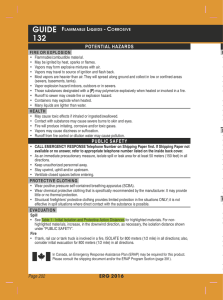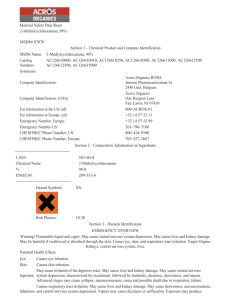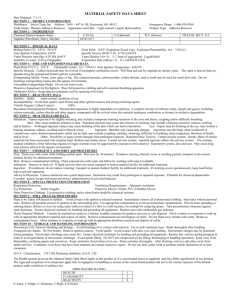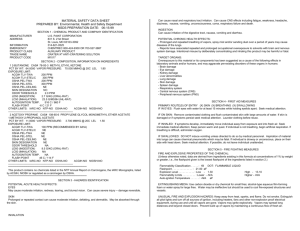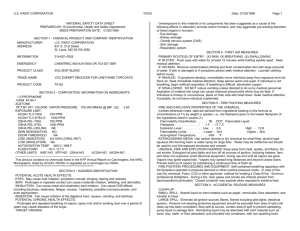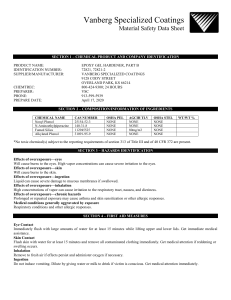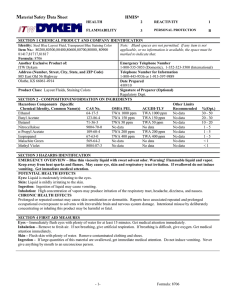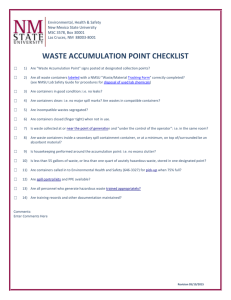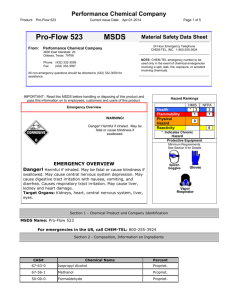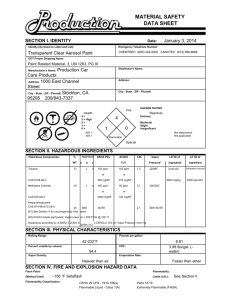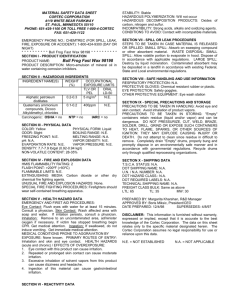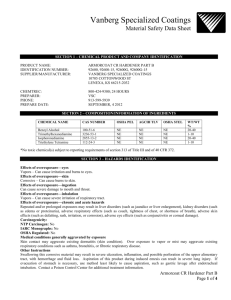Fuels B-99 MSDS: Safety Data Sheet
advertisement
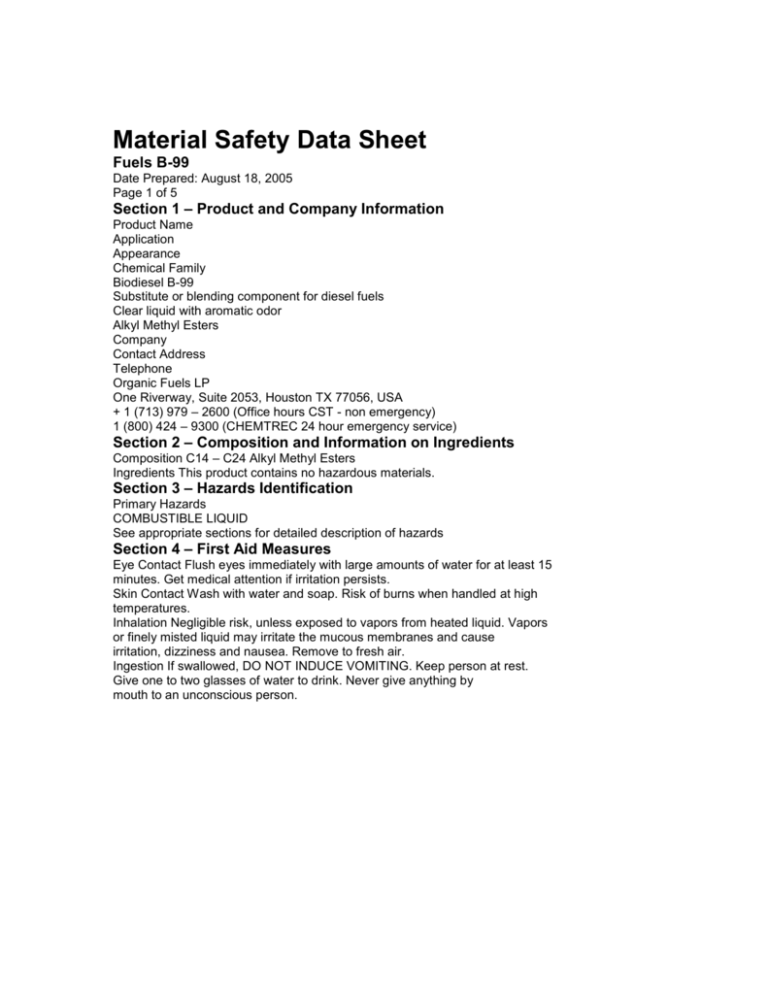
Material Safety Data Sheet Fuels B-99 Date Prepared: August 18, 2005 Page 1 of 5 Section 1 – Product and Company Information Product Name Application Appearance Chemical Family Biodiesel B-99 Substitute or blending component for diesel fuels Clear liquid with aromatic odor Alkyl Methyl Esters Company Contact Address Telephone Organic Fuels LP One Riverway, Suite 2053, Houston TX 77056, USA + 1 (713) 979 – 2600 (Office hours CST - non emergency) 1 (800) 424 – 9300 (CHEMTREC 24 hour emergency service) Section 2 – Composition and Information on Ingredients Composition C14 – C24 Alkyl Methyl Esters Ingredients This product contains no hazardous materials. Section 3 – Hazards Identification Primary Hazards COMBUSTIBLE LIQUID See appropriate sections for detailed description of hazards Section 4 – First Aid Measures Eye Contact Flush eyes immediately with large amounts of water for at least 15 minutes. Get medical attention if irritation persists. Skin Contact Wash with water and soap. Risk of burns when handled at high temperatures. Inhalation Negligible risk, unless exposed to vapors from heated liquid. Vapors or finely misted liquid may irritate the mucous membranes and cause irritation, dizziness and nausea. Remove to fresh air. Ingestion If swallowed, DO NOT INDUCE VOMITING. Keep person at rest. Give one to two glasses of water to drink. Never give anything by mouth to an unconscious person. Material Safety Data Sheet Fuels B-99 Date Prepared: August 18, 2005 Page 2 of 5 Section 5 – Fire Fighting Measures Flammability COMBUSTABLE LIQUID. The vapors form flammable mixtures with air at temperatures at or above the flashpoint. Liquids or vapors can accumulate a static electrical charge that can cause ignition. Containers must be grounded when filled or emptied. Empty containers can contain liquid or vapor residue that can ignite and explode at elevated temperatures. DO NOT EXPOSE SUCH CONTAINERS TO HEAT, FLAMES, SPARKS, STATIC ELECTRICITY OR OTHER SOURCES OF IGNITION – THEY MAY EXPLODE AND CAUSE INJURY OR DEATH. Empty containers such as drums and totes must be completely drained, closed off and properly recycled or disposed of. Flash Point: 130 0C to 160 0C (266 0F to 320 0F) Flammable Limits (vapor, in air, by volume): Not Known Extinguishing Media Foam, halon, dry chemicals, CO2. Use water spray or fog for cooling of surfaces only. Water may spread the burning liquid. Decomposition Products WARNING: HAZARDOUS FUMES. Smoke and fumes may contain carbon monoxide and nitrous oxide. Fire fighting personnel must wear proper protective clothing and breathing equipment. Section 6 – Accidental Release Measures Spill Response Immediately eliminate all potential sources of ignition. Contact emergency personnel. Prevent spilled liquid from entering sewers, drains, watercourses or low areas. Contain with sand, earth or other non-flammable absorbents. Do not use sawdust. Avoid contact with spilled material. Wear proper protective equipment when dealing with a spill. For spills on water, immediately warn shipping and other activities in downwind areas. Contain spill using floating booms. Recover with suitable absorbent. All other precautionary measures outline above for land spills also apply. Clean Up and Disposal Spilled liquid can be recovered by pumping or absorbents. Use only hand pumps or pumps with explosion proof motors. Dispose of recovered material in compliance with local regulations. Wash surfaces with water and detergent. The greasy nature of the product may cause surfaces to be slippery after a spill. Environmental Impact The product is not an environmental pollutant and will decompose naturally without harmful byproducts. Material Safety Data Sheet Fuels B-99 Date Prepared: August 18, 2005 Page 3 of 5 Section 7 – Handling and Storage Storage Preferably store at temperatures between 10 0C and 50 0C (50 0F to 120 0F). Do not handle and store near open flames, or other sources of heat or ignition. Handling Handle with care. DO NOT EXPOSE EMPTY CONTAINERS TO HEAT, FLAMES OR OTHER SOURCES OF IGNITION. Electrostatic Hazard Liquid and vapors can accumulate an electrostatic charge which can lead to ignition, fire and explosion. Keep containers grounded at all times when transferring product. Section 8 – Exposure Control and Personal Protection Engineering Controls If vapors or mists are generated, provide exhaust ventilation to keep airborne concentrations of vapors below maximum allowable concentrations. Use explosion proof ventilation equipment. Locate exhaust in safe location. Protective Equipment Safety glasses, goggles, or a face shield, as well as PVC coated or similar gloves are recommended in operations where exposure to mists or splashed liquid is possible (for instance, during sampling, tank gauging, line breaking, drumming and open hatch loading). Section 9 – Physical and Chemical Properties General Properties Pale yellow liquid with aromatic odor Specific Gravity (Liquid) 0.88 at 15 0C (60 0F) Specific Gravity (Vapor) Significantly heavier than air Vapor Pressure 2 mm Hg at 20 0C (68 0F) Solubility in Water Unsoluble Flash Point 130 0C to 160 0C (266 0F to 320 0F) Section 10 – Stability and Reactivity Stability Stable. Product may biodegrade if stored over prolonged periods. Materials to Avoid Strong oxidizing agents. Conditions to Avoid Temperatures above 60 0C (140 0F), sparks, flames, electric discharges. Material Safety Data Sheet Fuels B-99 Date Prepared: August 18, 2005 Page 4 of 5 Section 11 – Toxicological Information Toxicity The product contains no hazardous or toxic materials. Extensive testing of toxicity, aquatic toxicity and biodegradability of biodiesel by the University of Idaho revealed no significant adverse health effects or hazard to the environment. (http://www.uidaho.edu/bioenergy/BiodieselEd/publication/04.pdf) Section 12 – Ecological Effects Environmental Hazards Not hazardous to the environment. Please refer to Section 6 for spill response. Environmental Fate This product is fully biodegradable. Section 13 – Disposal Considerations Product Waste Product can be disposed of by combustion or landfill. All waste must be disposed of in accordance with federal, state and local environmental regulations. Packaging Empty containers may contain flammable vapors and explosive vapor/air mixtures. See Section 5 for additional guidelines. Section 14 – Transportation Information DOT Classification N/A Description Fatty Acid Ester NMFC Identification Number 144920 Shipping Classification 65 Section 15 – Regulatory Information TSCA TSCA Inventory Listing UVBC (Unknown, Variable or Biological) CERCLA Not Reportable SARA Title III Other No components listed under section 311, 312 or 313. California Prop 65: This product contains no chemicals known to cause cancer Material Safety Data Sheet Fuels B-99 Date Prepared: August 18, 2005 Page 5 of 5 Section 16 – Other Information Application This product is prepared solely for the use in diesel engines either as is or in blends with petroleum derived diesel fuel. Caution This information relates to the specific product described herein, and may not be valid or complete for such product when used in combination with other materials or in processes for which it was not intended. The information contained herein is compiled to the best of our knowledge and is believed to be accurate and reliable as of the date of issue. However, no representation, warranty or guarantee is made as to its accuracy. It is the user’s responsibility to verify the suitability and completeness of such information for the user’s particular circumstances. We do not accept any liability for loss or damage that may occur from the use of this information nor do we offer any warranty against patent infringement.
